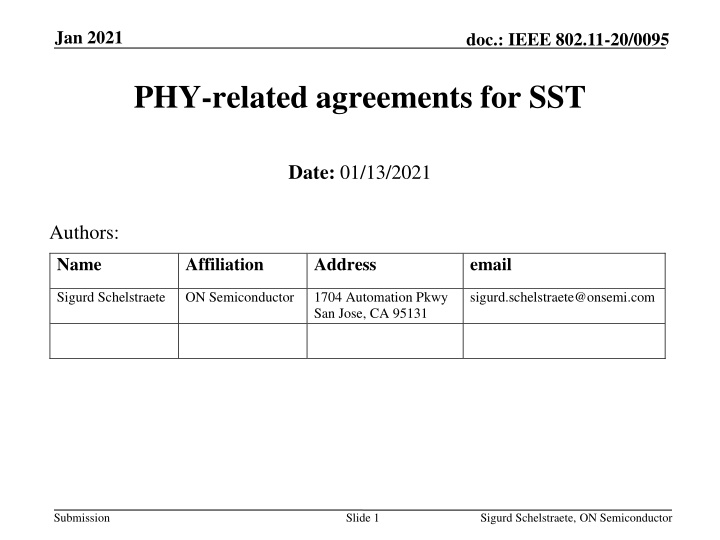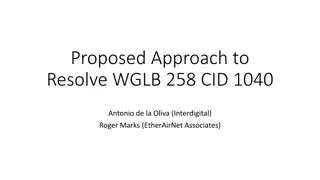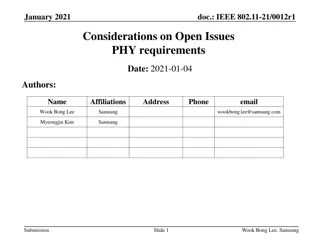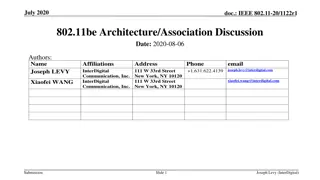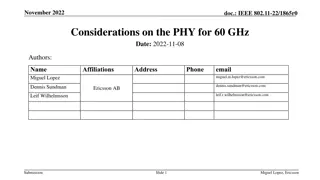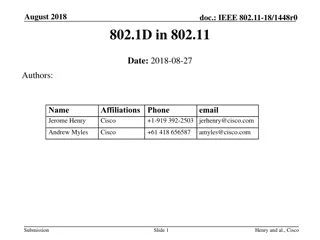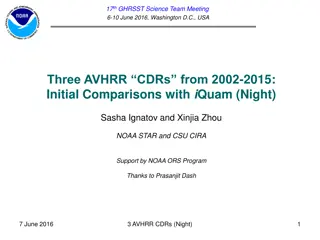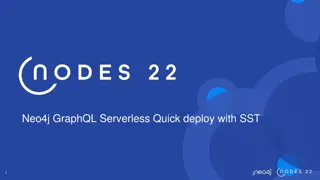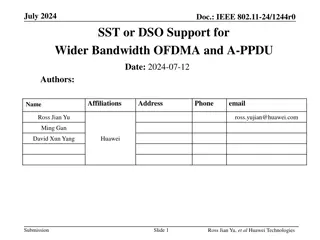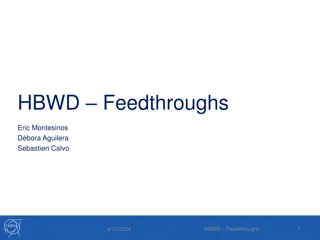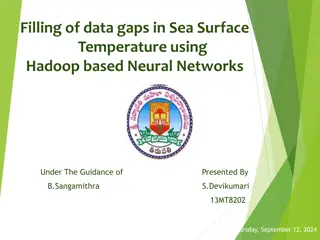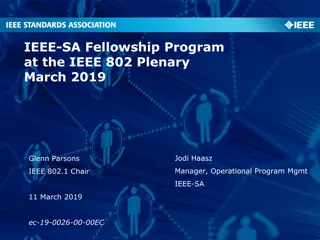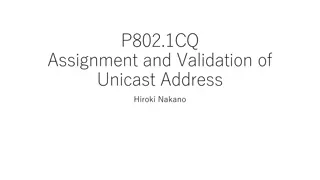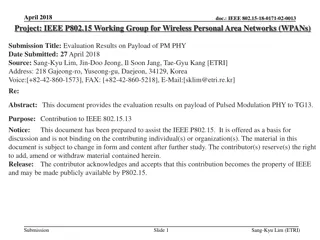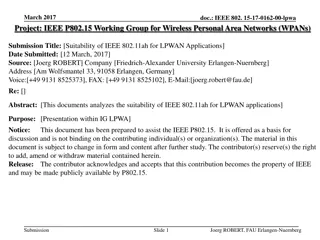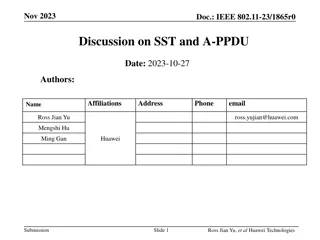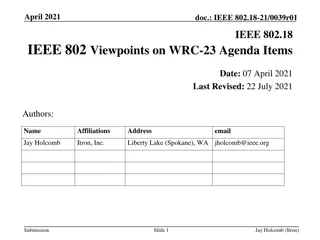IEEE 802.11-20/0095 PHY-Related Agreements for SST
IEEE 802.11-20/0095 outlines agreements related to PHY aspects impacting the definition of Spatial Stream Tapping (SST) in 802.11 standards. The focus is on enabling 80 MHz operating stations to participate in 160 MHz OFDMA, including in non-primary 80 MHz scenarios. Various considerations and scenarios for SST implementation, such as preamble processing in non-primary 80 MHz channels, are discussed.
Download Presentation

Please find below an Image/Link to download the presentation.
The content on the website is provided AS IS for your information and personal use only. It may not be sold, licensed, or shared on other websites without obtaining consent from the author.If you encounter any issues during the download, it is possible that the publisher has removed the file from their server.
You are allowed to download the files provided on this website for personal or commercial use, subject to the condition that they are used lawfully. All files are the property of their respective owners.
The content on the website is provided AS IS for your information and personal use only. It may not be sold, licensed, or shared on other websites without obtaining consent from the author.
E N D
Presentation Transcript
Jan 2021 doc.: IEEE 802.11-20/0095 PHY-related agreements for SST Date: 01/13/2021 Authors: Name Affiliation Address email Sigurd Schelstraete ON Semiconductor 1704 Automation Pkwy San Jose, CA 95131 sigurd.schelstraete@onsemi.com Submission Slide 1 Sigurd Schelstraete, ON Semiconductor
Jan 2021 doc.: IEEE 802.11-20/0095 Introduction 802.11ax defines SST, which allows 80 MHz operating STAs to participate in 160 MHz OFDMA, even in non- primary 80 MHz It s expected that SST will be defined for 802.11be, with possible enhancements (320 MHz, ) SST mode of operation requires both PHY and MAC elements to be specified Purpose of this submission is to highlight some PHY- related agreements that will impact the definition of SST Submission Slide 2 Sigurd Schelstraete, ON Semiconductor
Jan 2021 doc.: IEEE 802.11-20/0095 Relevant agreements reached in PHY ad- hoc 80 MHz operating STAs are required to support participation in 160 MHz and 320 MHz OFDMA 80 MHz could be primary or non-primary 80 MHz Support for operation in non-primary 80 MHz is expected Full extent TBD RU allocation to 80 MHz operating STAs could be outside the primary 80 MHz STA is not required to process more than one 80 MHz segment for preamble decoding Specifically, no 80 MHz segment change is needed while processing L-SIG, U-SIG and EHT-SIG Submission Slide 3 Sigurd Schelstraete, ON Semiconductor
Jan 2021 doc.: IEEE 802.11-20/0095 Issue: preamble processing in non-primary 80 MHz (with possible puncturing) For an 80 MHz operating STA in a secondary 80 MHz, there is no guaranteed 20 MHz channel to decode U- SIG and learn about possible puncturing in the 80 MHz channel By contrast, in primary 80 MHz, the primary 20 MHz is always present Could mean different processing in primary 80 MHz vs. secondary 80 MHz Especially with puncturing, this adds processing complexity Reminder: STA is not expected to process more than its 80 MHz channel Submission Slide 4 Sigurd Schelstraete, ON Semiconductor
Jan 2021 doc.: IEEE 802.11-20/0095 Possible scenarios for non-primary 80 preamble processing How does the 80 MHz operating STA deal with puncturing in its (non-primary) 80 MHz channel? Option 1: STA autonomously finds a 20 MHz channel that is not punctured, without explicit information Option 2: Disallow puncturing in non-primary 80 MHz of wider band OFDMA transmission that includes 80 MHz-operating STAs in the non-primary 80 MHz Option 3: Provide a guaranteed non-punctured 20 MHz channel for 80 MHz-operating STAs in the non-primary 80 MHz PHY ad-hoc discussed the issue [3] and found strong support for Option 3 (SP results: 7/3/42) It was suggested that SFD SP should be run in the joint session Submission Slide 5 Sigurd Schelstraete, ON Semiconductor
Jan 2021 doc.: IEEE 802.11-20/0095 Required MAC support for Option 3 The details of the SST protocol and signaling will mostly be developed in the MAC ad-hoc As part of SST signaling, the STA should receive an indication of a guaranteed non-punctured 20 MHz within its non-primary 80 MHz It is requested that this requirement is taken into account during the definition of SST Submission Slide 6 Sigurd Schelstraete, ON Semiconductor
Jan 2021 doc.: IEEE 802.11-20/0095 160 MHz operating STAs Similar discussion and questions need to be resolved for 160 MHz operating STAs Submission Slide 7 Sigurd Schelstraete, ON Semiconductor
Jan 2021 doc.: IEEE 802.11-20/0095 Summary We ve highlighted some of the PHY-related agreements that may impact definition of SST in 802.11be Full definition of SST protocol needs to be consistent with these agreements Submission Slide 8 Sigurd Schelstraete, ON Semiconductor
Jan 2021 doc.: IEEE 802.11-20/0095 SP1 Do you agree that: for an 80 MHz operating STA that is assigned (by the AP) a non- primary 80 MHz channel in a 160 MHz or 320 MHz EHT MU PPDU (if such operation is defined), SST shall define a guaranteed non-punctured 20 MHz channel in that non-primary 80 MHz channel. Submission Slide 9 Sigurd Schelstraete, ON Semiconductor
Jan 2021 doc.: IEEE 802.11-20/0095 SP2 Do you agree that: for a 160 MHz operating STA that is assigned (by the AP) a non- primary 160 MHz channel in a 320 MHz EHT MU PPDU (if such operation is defined), SST shall define a guaranteed non- punctured 20 MHz channel in that non-primary 160 MHz channel. Submission Slide 10 Sigurd Schelstraete, ON Semiconductor
Jan 2021 doc.: IEEE 802.11-20/0095 References [1] Mandatory larger BW support, 20/0796r1, June 2020. [2] U-SIG structure and preamble processing, 20/0380r0, March 2020. [3] Clarification of 80 MHz operation in wider-BW OFDMA , 21/0015r1, January 2021 Submission Slide 11 Sigurd Schelstraete, ON Semiconductor
